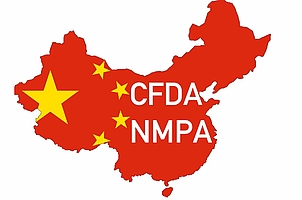CFDA, NMPA: Approval of Medical Devices in China
The CFDA, the China Food and Drug Administration, was replaced on September 1, 2018 by the National Medical Products Administration (NMPA), which reports to the Chinese Ministry of Health.
This article will provide you with further information on the work and responsibilities of the CFDA/NMPA and the approval of medical devices in China.
You will also learn about the changes resulting from the conversion to an electronic format. This will save you from unnecessary rejections from the authority.
1. CFDA (China FDA) and NMPA (National Medical Product Administration)
The state authority for market authorization was established in March 2018. The NMPA (National Medical Product Administration) is part of this. This, in turn, replaced the China Food and Drug Administration (CFDA).
As the name suggests, the NMPA is not only responsible for medical devices, it is also responsible for medicinal products, biological products, food and cosmetics. The NMPA has therefore taken over from the CFDA, particularly with regard to ensuring the safety of public health through safe and effective devices and products. Like the CFDA, the NMPA is the only authority responsible for the approval and registration of imported medical devices.
2. Medical device approval process in China
a) Overview
Like most other countries, the approval process in China depends on the class of the medical device. For class I devices - the lowest class - one submission, which the NMPA will make a direct decision on, is enough.
The hurdles are higher for imported class II and III medical devices. The “Center for Medical Device Evaluation (CMDE)”, part of the NMPA, conducts a technical review. Type testing by an NMPA-certified tester or testing laboratory is often necessary.
Although the CFDA/NMPA do not charge fees for these tests, they take a long time and the test results tend to be negative. Therefore, the Johner Institute regularly recommends testing by certified laboratories, even though you have to pay a fee.
b) Length of the process and validity of the approval process
The approval process takes longer for class III devices than for class II devices.
Class | Time (working days) | Costs | Period of validity |
I | Immediately | Free: initial/change/extension | N.A. |
II |
| RMB 210,900 / 42,000 / 40,800 (approx. EUR 26,500 / 5,300 / 5,150) | 5 years |
III |
| RMB 308,800 / 50,400 / 40,800 EUR 38,900 / 6,350 / 5,150 | 5 years |
3. Classification of medical devices
In August 2018, the CFDA/NMPA introduced a new classification system. As with the US FDA, there are three classes. The class is determined by the “product panel”, which in turn groups devices with similar applications and product codes together.
One of the Johner Institute’s contacts has developed an online classification tool. However, this tool is only available in Chinese, which is why we are offering to help you - with the help of our native Chinese speaking colleagues - identify the right class for your medical device.
4. Approval documents
a) Language
Like other regulatory authorities, the CFDA/NMPA expects comprehensive documentation. The documents must be submitted in the original language (if applicable) as well as in Chinese. Documents that are completely in Chinese, such as NMPA test reports, do not have to be translated into another language.
b) Overview of documentation
The documentation depends on the device type and approval type. The following table provides a non-exhaustive list:
Document list for NMPA registration submission
New registration | Change registration | Extension registration | |
Approval matter change | Record matter change | ||
|
|
|
|
N.B!
Please pay attention to the changes detailed below that apply to electronic submissions!
c) Standards
China insists on national standards. Fortunately, these are often identical, or at least similar, to international standards. The NMPA does not accept IEC 60601-X test report forms for the testing of electromagnetic compatibility and electrical safety. It also insists on national specifications.
Chinese standards are differentiated by their prefixes:
- GB: Binding/obligatory national standard
- GB/T: Non-binding/recommended national standard
- YY: Binding/obligatory industry standard for medicine
- YY/T: Non-binding/recommended industry standard for medicine
- JJG: Metrology measurement standard
An example of this would be GB9706.1-2007, which is identical to IEC60601.1:1988 + A1:1991+A2:1995.
5. Other CFDA/NMPA requirements
a) Quality management requirements
The Chinese authorities (CFDA/NMPA) have their own quality management system requirements. However, these “GMP requirements” (Notice N0. 218 Identical) are very similar to ISO 13485. Therefore, manufacturers usually submit the ISO 13485 certificate. However, the audit will review this certificate against the Chinese GMP requirements. These audits are regularly carried out during the approval procedure and/or after a recall (Level 1).
b) Clinical evaluation
A clinical evaluation is mandatory for imported class II and III medical devices. This evaluation is based on the results of clinical investigations/studies (e.g., published in specialist literature) and on non-clinical data. As with a 510(k) process, comparator devices can be used for this.
Clinical investigations are required if no equivalent devices can be found and safety and efficacy cannot be proven with other clinical and non-clinical data.
The NMPA has published its own guidelines (“Medical device clinical evaluation technical guidance”). This is similar to MEDDEV 2.7/1, but has different priorities.
The requirements for clinical investigation are still significantly different.
7. Electronic Regulated Product Submission, the NMPA's new registration system
In May 2019, the Chinese National Medical Products Authority (NMPA) published a new guidance document on the newly introduced electronic submission of approval documents (No. 29 and No. 46, 2019).
a) When electronic submissions can be made
Submissions can be made electronically for:
- The initial registration/approval of medical devices (including IVD devices)
- Changes to an existing registration of domestic class III medical devices and foreign class II and III medical devices
- Applications for clinical investigations for foreign class III medical devices
- Changes to a medical device’s instructions for use
- Extension of medical device licenses
- Applications for approval of innovative medical devices
- Changing, correcting and deregistering licenses for medical devices
- Applications for “type testing”, i.e., device testing at accredited testing laboratories required in China
b) Process
Current
Currently, the person responsible for the registration (for manufacturers with headquarters or a branch in China) or the Chinese agents (for foreign manufacturers who contract a consultancy firm to get the approval) has to submit the approval documents to the authority personally. The completeness of the documents is checked on-site.
Future
With the introduction of the new electronic registration system, it is possible to initially register for eRPS and then be assigned access. As well as uploading approval documents, manufacturers can use the eRPS to track the status of the approval and to re-submit documents or submit answers to questions from the authority.
This change means the NMPA is one step ahead of a lot of international regulatory authorities. For example, the FDA requires a hard copy to be submitted with an electronic copy (e-copy) on, for example, CD.
In addition to an electronic submission, which has been possible since June of this year, submissions can also be made to the authority on-site as a hard copy together with an electronic copy on CD, as with the FDA.
You can register via the website erps.cmde.org.cn. After a review by the authority within 30 days, the “Certificate Authority” must be collected personally. The “Certificate Authority” is a USB drive with a security certificate included. Only when the USB drive is plugged into a computer and the assigned password entered is it possible to log on to the eRPS system. Internal IT security regulations, e.g., the definition of usage and access rights, are a prerequisite for use.
Transitional period
In the transitional phase up to November 2019, submissions in hard copy can still be structured as per the old structure. From November 1, 2019, any hard copy submitted must follow the eRPS’ new electronic structure.
c) New structure of submission documents
Although they are slightly hidden, the guidance document does contain the requirements for the new structure of the submission documents. After Canada, China is now the second country to specify what the IMDRF's table of contents (ToC) has to contain. The approval documents are divided into 6 sections for the electronic structure:
- Regional regulatory information
- Information on the device
- Information on non-clinical data
- Information on clinical data
- User instructions and labeling
- Information on the quality system
At first glance, the eRPS may seem a bit confusing, but if you select the correct type of approval, a directory tree will be displayed and this can be used as a reference when filing the documents. The documents will be marked with R, CR or NR in this directory tree. R means mandatory, CR means that it must be submitted on request and NR means do not submit or not relevant for the current approval type.
Table comparing the old and new structure of approval documents
eRPS (electronic) | Old approval structure (in hard copy) |
Chapter 1 (CH1.XX) Regional administrative information | 1. Application form |
Chapter 2 (CH2.XX) Information on the device | 4. General device description |
Chapter 3 (CH3.XX) Information on non-clinical data | 3. Safety and effectiveness requirements |
Chapter 4 (CH4.XX) Information on clinical data | 7. Clinical evaluation |
Chapter 5 (CH5.XX) Instructions for use and labeling | 11. Instructions for use and labeling |
Chapter 6 (CH6.XX) Information on the quality management system | 6. Manufacturing information |
d) Evaluation
A big advantage of eRPS is that you can track the review status of the approval online. If there are missing or incorrect documents, the reviewer at the authority informs the applicant of what still has to be submitted. The plan is for it to be possible to exchange content with and receive feedback from the NMPA reviewer directly via the system before the final submission of documents.
The introduction of eRPS will save time for all foreign manufacturers. For example, original documents with signatures or legalization stamps will no longer have to be sent by post if the manufacturer decides to use the electronic submission process. Manufacturers will not have to print the documents on paper and submit them personally to the authority on schedule if they decide to make an electronic submission only.
Sources:
8. Additional information
a) Sources
- NMPA website
- CMDE website
- “Old” CFDA website
- Classification catalog for medical devices
- Supervision and administration regulation for medical devices
As the website transition has not been completed yet, a lot of links are broken and some content is incomplete.
b) Support

Please contact us if you require assistance with the approval of your medical devices and/or communication with the Chinese authorities, particularly the CFDA/NMPA. The Johner Institute and its team led by Dr. Liang Li will be happy to help.



